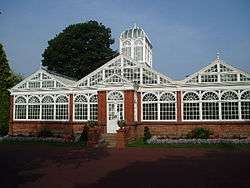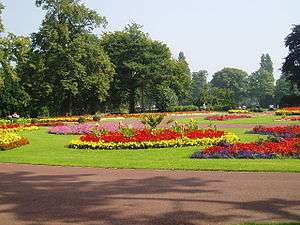West Park, Wolverhampton
| West Park | |
|---|---|
|
Formal flower beds, West Park, Wolverhampton | |
| Type | Public park |
| Location | Wolverhampton, England |
| Area | 17 hectares, 43 acres (inc. lake) |
| Created | 1881 |
| Operated by | Wolverhampton City Council |
| Status | Open year round |
| Website | West Park |
Formerly called the People's Park, Wolverhampton's West Park was opened on 6 June 1881.
Background
The site chosen for the first of the large parks in Wolverhampton was the Race Course, or Broad Meadows, owned by the Duke of Cleveland. On 12 March 1879, Alderman Samuel Dickonson, invited landscape gardeners to compete for the layout of the park. The winner of the £50 prize was Richard Hartland Vertegans of Chad Valley Nurseries, Edgbaston, Birmingham.[1] This was several years before Vertegans designed Victoria Park, Handsworth, Birmingham.[2] The remit from the council included:
- Ornamental lakes, 8 acres
- Areas for volunteer drill, archery, cricket and bowls, 12 acres
The park was opened on 6 June 1881 by the Mayor of Wolverhampton, Alderman John Jones.
The bandstand was presented by the town's long serving M.P., Rt. Hon. Charles Pelham Villiers, on 29 May 1882. Now Grade II listed, it was restored in 2002 at a cost of £70,000.
The conservatory was opened in July 1896 by the widow of former Mayor Alderman Samuel Dickinson. Built at a cost of £1,500, it had been funded by the 1893 Floral Fête, one of a series of annual fêtes held between 1889 and 1939.[1]

The largest and most ambitious exhibition held in Wolverhampton was the 1902 Arts and Industrial Exhibition which was sited in West Park. Although housing only one international pavilion, from Canada, the scope and scale of the exhibition mirrored all the advances in other exhibitions of its time. The exhibition site featured several large halls housing machinery, industrial products, a concert hall, two bandstands, a restaurant, and a fun fair with thrill rides and a water chute. Its opening, by the Duke of Connaught, was received with hopeful enthusiasm, unfortunately not matched by the weather, which contributed to a £30,000 loss, equivalent to nearly £2M at today's value.[3][4]
In 1911 commemorative flower beds were set out for the coronation of King George V; similarly in 1937 for King George VI. During World War I ducks and rabbits were raised, and vegetables grown, to aid the war effort. In 1942 the park was turned into allotments and the normal closing time was extended to allow for the extra work involved. The park was placed on the Heritage National Register of Parks and Gardens of Special Historic Interest in 1986. A grant was received from the Heritage Lottery Fund in 2005 to refurbish the tea room.[1]
Gallery
 Grade II listed bandstand, 1882
Grade II listed bandstand, 1882 Tea Room, refurbished in 2005
Tea Room, refurbished in 2005 Lakeside pavilion
Lakeside pavilion South Gate lodge, West Park
South Gate lodge, West Park A flock of Canada Geese, Branta Canadensis
A flock of Canada Geese, Branta Canadensis
Today

Most facilities are free or at nominal cost:
- Boating lake
- Picnicking
- Tennis courts
- Tearooms
- Children's play area
- Disabled access
- Guide dogs welcome
- Bowling green (situated in Park Crescent)
- Victorian conservatory: global plant collection
The park hosts:
- Weekly summer brass band concerts on the recently restored bandstand
- Events, walks and activities organised and run by the park Ranger Service.
- Wolverhampton Show (Summer)
- Annual Bonfire & Fireworks Display
- Steam and Vintage Rally
- Other special events[5]
External links
| Wikimedia Commons has media related to West Park, Wolverhampton. |
- Black Country History, Archive Photos
- List entry, Register of Historic Parks and Gardens, English Heritage
- West Park Conservatory Virtual Tour
- Wolverhampton City Council, West Park
- Wolverhampton History & Heritage Website, Wolverhampton's Listed Buildings, West Park
References
- 1 2 3 "West Park, Wolverhampton". Black Country History. Retrieved 6 November 2012.
- ↑ "Handsworth Park, (also known as Victoria Park), Birmingham, England". Parks and Gardens Data Services. Retrieved 6 November 2012.
- ↑ Frank Sharman. "Exhibitions Great and Small". Wolverhampton History & Heritage Website. Retrieved 15 October 2012.
- ↑ "Currency Converter". National Archive. Retrieved 16 October 2012.
- ↑ "West Park". Wolverhampton City Council. Retrieved 7 November 2012.

